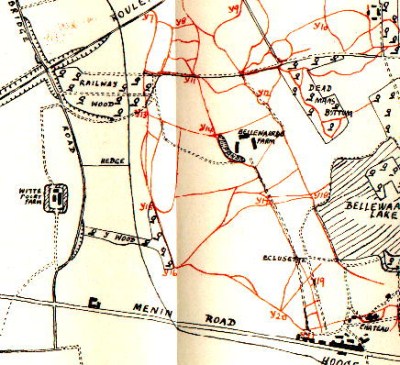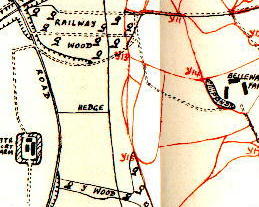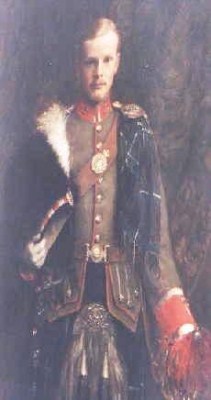Hooge 1915
Battle of Hooge (First Action at Bellewaarde)

The first major battalion action of the Liverpool Scottish was on 16th. June 1915 in what is officially known as 'The First Action at Bellewaarde' which was designed to pin down German reserves whilst there were British and French attacks elsewhere.This action is known in The Liverpool Scottish as 'The Battle of Hooge'. Hooge is a village is a few miles East of Ieper (Ypres), straddling the Menin Road (click here for a more detailed map). The Liverpool Scottish, as part of 9th Brigade ( in turn part of the 3rd Division of the Regular Army) , were to take part in the second phase of the attack on ground just north of the Menin Road between (and including) Railway Wood (still to be seen) in the north and a hedge row seen on the map to the south. Further to the south was a feature known as Y-Wood which no longer exists. An account of the action of the 4th Bn Gordon Highlanders in Y Wood is on Robert Patrick Gordon's memorial page. They were to be the left hand battalion and to their right was to be a battalion of the Lincolns. (contrary to the map in the war diary of the 3rd Division that shows the Liverpool Scottish on the right) The battalion's frontage appears to have been about 400 yards. The assembly position was on the line of 'Cambridge Road', a feature which exists today as a metalled road running north from the Menin Road. This is indicated today by the signs off the Menin Road: a CWGC sign for "Re Grave" and a brown Ieper city sign for "Liverpool Scottish Stone". On Saturday 29th July 2000 during the Regiments centenary year the Museum was actively involved in the unveiling and dedication of a memorial to the Liverpool Scottish. Further details of the dedication may be found with photographs may be found here on both the unveiling and the Menin Gate ceremony there is also a Memorial history and background page.
The Battle Field (North is at the top)
 Scale: the distance from the junction of Cambridge Road with the railway in the North to the junction of Cambridge Road with the Menin Road in the South is about 750 metres. The red lines represent the German trenches.
Scale: the distance from the junction of Cambridge Road with the railway in the North to the junction of Cambridge Road with the Menin Road in the South is about 750 metres. The red lines represent the German trenches.
Witte Poort Farm exists on the site marked today and the ground remains farm land
Railway Wood still occupies much the same area on the map but Y Wood no longer exists.The railway is now a road.
The track leading South from the eastern end of Railway Wood still exists and runs across the top of Bellewaarde Ridge towards the Cross of Remembrance at the RE Grave.
Bellewaarde Farm is now in woodland which occupies the southern part of the ridge top. 'Hooge' means 'high' in Flemish/Dutch
This map is taken extracted from 'The Liverpool Scottish 1900-1919" by Major (later Lt Colonel) A.M McGilchrist published by Henry Young & Sons, Liverpool, 1930. The author was an officer with The Liverpool Scottish during the First World War and was still serving at the time of writing.
The Attack

 The Battalion moved off into the attack uphill towards Bellewaarde Farm (the crest line is today occupied by the CWGC Cross of Sacrifice of the RE Grave) at a strength of 23 Officers and 519 Other Ranks. At the end of the day, there were 2 Officers and 140 ORs unscathed. There were 4 Officers and 75 ORs killed, 6 Officers and 108 ORs missing (of whom almost all were later reported killed) and 11 Officers and 201 ORs wounded. An indication of the scale of the casualties is that the account of the action in the war diary is signed by Lieutenant, L.G. Wall, as Commanding Officer of The Liverpool Scottish. Amongst the dead were Lt. Kenneth Alexander Gemmell, 2/Lt John Christian Barber and Capt. Bryden McKinnell M.C. whose fine portraits hung until recently in the Liverpool Scottish Officers' Mess. Gemmell's portrait is to the left and the Barber's to the right. They are presently displayed at the HQ of the Reserve Force and Cadets Assciation in Liverpool. Captain McKinnell wrote a fine diary
The Battalion moved off into the attack uphill towards Bellewaarde Farm (the crest line is today occupied by the CWGC Cross of Sacrifice of the RE Grave) at a strength of 23 Officers and 519 Other Ranks. At the end of the day, there were 2 Officers and 140 ORs unscathed. There were 4 Officers and 75 ORs killed, 6 Officers and 108 ORs missing (of whom almost all were later reported killed) and 11 Officers and 201 ORs wounded. An indication of the scale of the casualties is that the account of the action in the war diary is signed by Lieutenant, L.G. Wall, as Commanding Officer of The Liverpool Scottish. Amongst the dead were Lt. Kenneth Alexander Gemmell, 2/Lt John Christian Barber and Capt. Bryden McKinnell M.C. whose fine portraits hung until recently in the Liverpool Scottish Officers' Mess. Gemmell's portrait is to the left and the Barber's to the right. They are presently displayed at the HQ of the Reserve Force and Cadets Assciation in Liverpool. Captain McKinnell wrote a fine diary  which has been used as a source in major works on the Great War. Additionally, there exist amazing photographs of the attack, taken by Private F.A. Fyfe of Z Company as he lay wounded by the German front line, showing soldiers of The Scottish advancing under fire and an artillery officer and his signaller crossing the German parapet with wounded soldiers in the foreground. Fyfe was a press photographer by profession and his (illegal) photographs made the front pages of the national press a short while later.
which has been used as a source in major works on the Great War. Additionally, there exist amazing photographs of the attack, taken by Private F.A. Fyfe of Z Company as he lay wounded by the German front line, showing soldiers of The Scottish advancing under fire and an artillery officer and his signaller crossing the German parapet with wounded soldiers in the foreground. Fyfe was a press photographer by profession and his (illegal) photographs made the front pages of the national press a short while later.
Awards for Valour and Distinguished Conduct
It was for his efforts in this action that the Battalion's medical officer, Lt. Noel Chavasse, (later Captain) received the Military Cross. He was later to receive the Victoria Cross in 1916 and, posthumously, a Bar to his VC in 1917. Few other awards were made for the action at Hooge; it is said that the list of recommendations was lost in a fire at Brigade HQ. Three men (Cpl. S. Smith, Private W. Short and Pte. F.F. Bell) received the Distinguished Conduct Medal (DCM) on the recommendation of other battalions. Belatedly, ten men were awarded the Military Medal on its inception in 1916 for their work at Hooge in the previous year. Altogether the Regimental Historian lists 293 names in the list of honours and awards for service during the Great War. One recipient of the Military Medal was the highly articulate and well-educated Regimental Quarter Master Sergeant, R.A. Scott Macfie, who later became a world expert on Gypsies and some of whose meticulously written field notebooks form part of the Museum collection. The Imperial War Museum also holds some Scott McFie material and has made use of it in IWM publications. The University of of Liverpool holds the extensive Scott Meifie Gypsy Lore Collection
During the course of the Great War, The Liverpool Scottish continued to see front line action in France and Belgium, joining the 55th (West Lancashire) Division when it was reconstituted in France in January 1916. Its motto was to be 'They win or die who wear the rose of Lancaster'.
Previous page: Winter in the Trenches 1914-15
Next page: Guillemont 1916